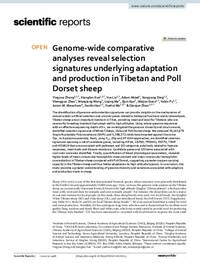Genome‑wide comparative analyses reveal selection signatures underlying adaptation and production in Tibetan and Poll Dorset sheep

Authors:
The identification of genome-wide selection signatures can provide insights on the mechanisms of natural and/or artificial selection and uncover genes related to biological functions and/or phenotypes. Tibetan sheep are an important livestock in Tibet, providing meat and wool for Tibetans who are renown for breeding livestock that adapt well to high altitudes. Using whole-genome sequences with an effective sequencing depth of 5×, we investigated the genomic diversity and structure and, identified selection signatures of White Tibetan, Oula and Poll Dorset sheep. We obtained 30,163,679 Single Nucleotide Polymorphisms (SNPs) and 5,388,372 indels benchmarked against the ovine Oar_v4.0 genome assembly. Next, using FST, ZHp and XP-EHH approaches, we identified selection signatures spanning a set of candidate genes, including HIF1A, CAPN3, PRKAA1, RXFP2, TRHR and HOXA10 that are associated with pathways and GO categories putatively related to hypoxia responses, meat traits and disease resistance. Candidate genes and GO terms associated with coat color were also identified. Finally, quantification of blood physiological parameters, revealed higher levels of mean corpuscular hemoglobin measurement and mean corpuscular hemoglobin concentration in Tibetan sheep compared with Poll Dorset, suggesting a greater oxygen-carrying capacity in the Tibetan sheep and thus better adaptation to high-altitude hypoxia. In conclusion, this study provides a greater understanding of genome diversity and variations associated with adaptive and production traits in sheep.
